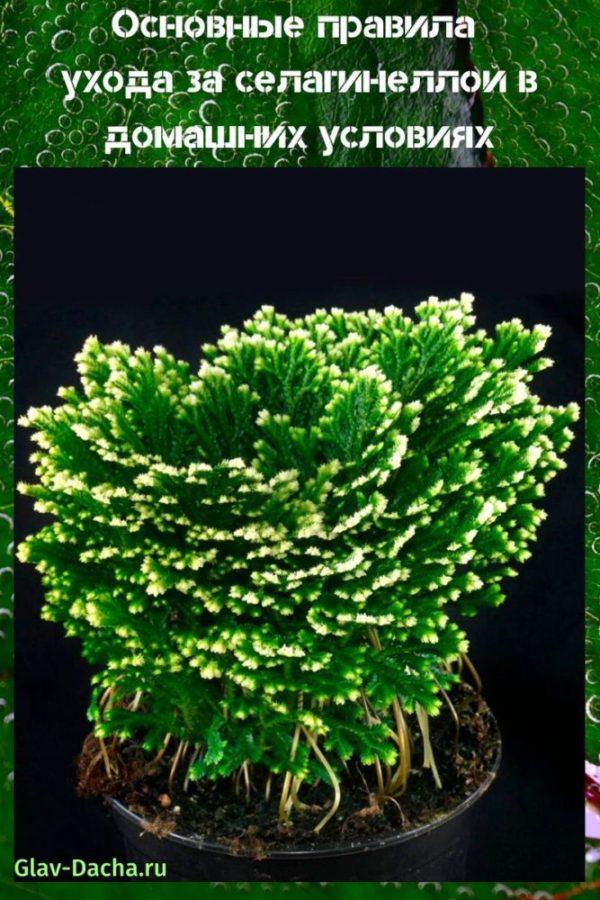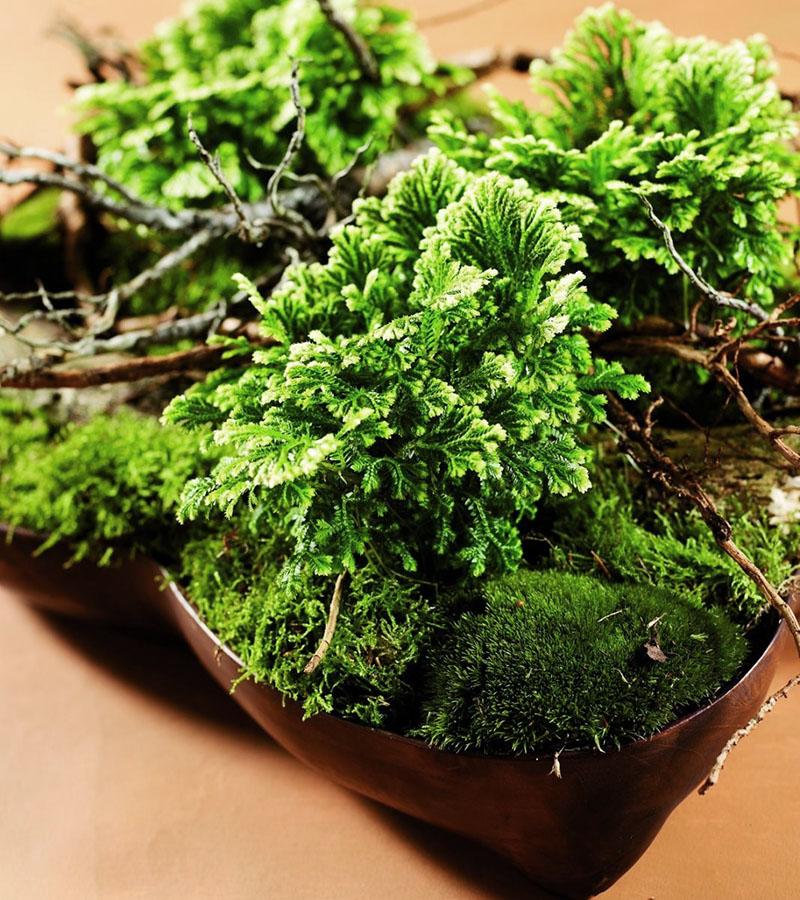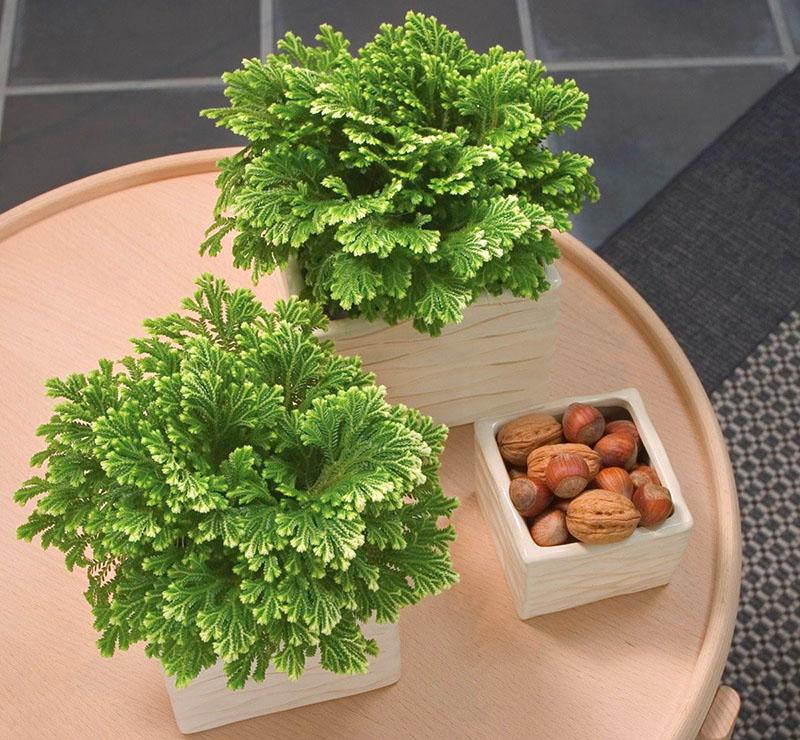Basic rules for caring for selaginella at home
 Selaginella is one of the most beautiful and spectacular ground cover indoor plants, with a history of over 300 million years. Caring for selaginella at home has several important nuances, since this relict plant requires special care and maximum attention. When grown correctly, you can get a surprisingly beautiful, lush plant that will decorate any interior.
Selaginella is one of the most beautiful and spectacular ground cover indoor plants, with a history of over 300 million years. Caring for selaginella at home has several important nuances, since this relict plant requires special care and maximum attention. When grown correctly, you can get a surprisingly beautiful, lush plant that will decorate any interior.
Botanical description of the plant

Under natural conditions, Selaginella grows in the tropical forests of America, South Africa, and in East Asia. Outwardly, the plant resembles a fern - it has creeping or slightly rising shoots, covered with small leaves-needles.
The main features of Selaginella:
- the underside of the shoots is covered with small growths - these are the adventitious roots of selaginella, which help the plant to root and absorb moisture from the air;
- leaves are small, soft, flat to the touch, up to 5 cm long;
- leaves are arranged in two rows and overlap each other in the form of scales;
- leaf cover is shiny or dull, light green, yellowish or bluish black;
- small spikelets appear on the tips of some shoots, in which plant spores mature;
- Selaginella has a superficial root system.
The length of shoots when grown at home does not exceed 8-10 cm, in the wild it can reach 15-20 m. There are more than 300 varieties of Selaginella, 30 of which are grown at home.
Caring for Selaginella at home
 Caring for selaginella houseplants is quite difficult and laborious, since they very poorly tolerate a lack of moisture in the air and substrate and die. But subject to the basic rules and nuances of cultivation, this tropical flower can be kept at home.
Caring for selaginella houseplants is quite difficult and laborious, since they very poorly tolerate a lack of moisture in the air and substrate and die. But subject to the basic rules and nuances of cultivation, this tropical flower can be kept at home.
The plant is most often grown in ampels or separate containers. Thanks to its colorful and attractive color variety, original ornaments and the shape of the leaf blades, Selaginella or Ampelya is considered the real queen of carpet crops grown at home.
Lighting and temperature control
 Proper lighting plays an important role in caring for selaginella at home. The plant cannot be placed on the windowsill in direct sunlight, as this will burn the delicate leaves.
Proper lighting plays an important role in caring for selaginella at home. The plant cannot be placed on the windowsill in direct sunlight, as this will burn the delicate leaves.
 The best option for placing tropical selaginella will be a window sill on the east or west side, with diffused, shaded light, away from penetrating drafts. The plant tolerates seasonal changes in lighting well and does not require additional light sources in the winter season.
The best option for placing tropical selaginella will be a window sill on the east or west side, with diffused, shaded light, away from penetrating drafts. The plant tolerates seasonal changes in lighting well and does not require additional light sources in the winter season.
 The optimum temperature for caring for Selaginella at home depends on the type of tropical plant. Some species require a temperature not lower than + 21 ° С, others feel quite comfortable at + 12 ° С.
The optimum temperature for caring for Selaginella at home depends on the type of tropical plant. Some species require a temperature not lower than + 21 ° С, others feel quite comfortable at + 12 ° С.
Absolutely all types of selaginella do not tolerate heat - they begin to fade, darken, and lose leaves.Short-term temperature changes do not pose any danger to the life of the lyre, but can negatively affect its decorative appearance.
Watering and air humidity
 For the active growth and development of Selaginella, regular watering throughout the year is very important. Watering can be done either directly from a watering can onto the soil or into a flower tray. For this purpose, only rain or filtered, pre-separated water at room temperature is used.
For the active growth and development of Selaginella, regular watering throughout the year is very important. Watering can be done either directly from a watering can onto the soil or into a flower tray. For this purpose, only rain or filtered, pre-separated water at room temperature is used.
You need to carefully monitor the soil in the pot - it should not dry out. It should be loosened regularly. This will make the substrate more permeable to moisture, oxygen and nutrients.
Caring for a selaginella flower includes maintaining the necessary air humidity. This plant is native to tropical forests, so high humidity is very important for it.
It can be increased in various ways:
- spray the plant with warm water twice a day;
- place a flower pot in a container with expanded clay or moistened moss;
- install a humidifier in the room;
- place selaginella in an aquarium, terrarium or low, wide flowerpot.
When planting selaginella in an aquarium or terrarium, pebbles, a layer of sphagnum moss should be poured onto the bottom of the container, water them abundantly and set inside a pot with a plant. For the normal growth of a tropical lyre in an aquarium or terrarium, there must be good ventilation.
Pot and soil selection
 Before caring for Selaginella, you need to prepare suitable containers. The plant has a root system with short, shallow roots. Therefore, it is best to choose not too deep pots for growing it. But the containers should be wide enough, since the lush flower bushes will completely fill the pot and will be cramped.
Before caring for Selaginella, you need to prepare suitable containers. The plant has a root system with short, shallow roots. Therefore, it is best to choose not too deep pots for growing it. But the containers should be wide enough, since the lush flower bushes will completely fill the pot and will be cramped.
It is best to prepare a low and wide ceramic or clay pot with drainage holes in the bottom. A layer of drainage should be poured onto the bottom of the container - broken brick, expanded clay, pebbles.
It is advisable to cover the pallet under the pot with sphagnum moss.
 For Selaginella, loose, light, breathable soil, neutral or slightly acidic, is suitable. To grow a tropical plant, you can use store-bought begonia growing medium or Saintpaulius.
For Selaginella, loose, light, breathable soil, neutral or slightly acidic, is suitable. To grow a tropical plant, you can use store-bought begonia growing medium or Saintpaulius.
You can also make a mixture of turf or garden soil and peat in equal proportions. For greater lightness and nutritional value, you can add a little charcoal or sphagnum moss to the substrate.
Transplanting, feeding and pruning
 Selaginella grows very slowly, so it does not need frequent transplants. It is quite enough to replant a tropical plant every two years. You can determine the need for transplanting by the noticeable hanging of the leaves from the pot.
Selaginella grows very slowly, so it does not need frequent transplants. It is quite enough to replant a tropical plant every two years. You can determine the need for transplanting by the noticeable hanging of the leaves from the pot.
The best time for transplanting Selaginella is early spring. For replanting, part of the soil in the flower pot is replaced. The plant must be carefully removed from the container and the bottom layer of soil must be cleaned, being careful not to damage the roots.
 Selaginella needs regular feeding from March to September. During the first 12 months after planting, the crop is fed once every 4 weeks with nitrogenous liquid fertilizers intended for decorative deciduous indoor crops.
Selaginella needs regular feeding from March to September. During the first 12 months after planting, the crop is fed once every 4 weeks with nitrogenous liquid fertilizers intended for decorative deciduous indoor crops.
In the second year, top dressing of the plow should be carried out more often, 2 times a month, as the soil becomes less fertile. The portion of fertilizer is reduced by 2 times, after applying top dressing, you should carefully loosen the soil in the pot.
2 years after planting, Selaginella grows noticeably and needs pruning. During the procedure, more than half of the length of the shoots is removed - due to this, young lateral shoots begin to grow actively from the "sleeping" buds.
Reproduction of selaginella
 Selaginella reproduces by cuttings, spores and bush division.It is the latter method that is considered the most suitable for reproduction of a tropical plant at home - overgrown bushes divide easily and take root quickly. Selaginella cuttings are no less popular.
Selaginella reproduces by cuttings, spores and bush division.It is the latter method that is considered the most suitable for reproduction of a tropical plant at home - overgrown bushes divide easily and take root quickly. Selaginella cuttings are no less popular.
Plant propagation by cuttings:
- first of all, you need to cut off a small fragment of the stem 3-4 cm long;
- after that, it should be placed horizontally in a container on a wet mixture of peat and sand;
- Sprinkle the tip of the shoot with a damp substrate and cover the container with a lid, plastic wrap or a plastic bottle;
- leave the container in a warm and shaded place;
- the substrate in the container must be constantly moist;
- after the roots appear, the plant can be transplanted into a separate flower pot.
Selaginella cuttings can be rooted in water. To do this, the stalk should be placed in a glass with a stimulant drug (Zircon or Kornevin), covered with plastic wrap and left in a warm place. When the roots appear, the tropical plant can be transplanted into separate containers.
Selaginella is a beautiful and unusual tropical plant that requires patience and care to grow. With proper care, you can grow luxurious, lush bushes that will decorate your apartment.